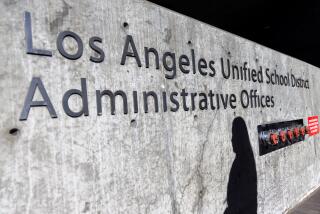Hacienda La Puente district ordered to pay $2.8 million in school sex-abuse case
A high school student who was drawn into a sexual relationship with her teacher won a $2.8-million judgment Thursday against the Hacienda La Puente Unified School District.
A Los Angeles Superior Court jury found that the “negligent supervision” of Los Altos High School Principal Cheli McReynolds was a “substantial factor in causing harm” to the girl.
An attorney for the student said other district employees also shared blame for not uncovering the predatory behavior by the teacher, David Park, at the Hacienda Heights campus.
“My client brought this case because she wanted to hold the school district accountable for its actions and to send a message to other school districts,” Stephen J. Estey said. “She feels a whole lot of shame for what happened. But the shame belongs to the school district and to Park. The jury verdict puts the shame where it belongs.”
School district officials said they also are distressed over what happened.
“We shared in the outrage when we learned of this teacher’s actions,” they said in a statement. “We believe that the verdict in this case acknowledges that the harm was primarily a result of the perpetrator’s actions.”
The full jury award is $8 million, but jurors assigned 65% of the blame — and the responsibility for damages — to Park. Estey said it’s unlikely that he’ll be able to collect from Park.
In December 2015, Park pleaded guilty to one felony count of oral copulation with a person under 16 and one felony count of a lewd act upon a child, according to the L.A. County district attorney’s office. He was sentenced to three years in state prison.
School districts are not liable for sexual misconduct by employees unless they could have done something to prevent it. Estey described a narrative of what happened to his client, adding that district staff missed important warning signs.
A parent, he said, had complained that Park was giving gifts to students, including a purse to the parent’s daughter. Park was warned against this behavior, but the incident was not documented.
In February 2015, after Park’s arrest, a teacher interviewed by police reportedly told officers that he saw Park, who was 37, spending a lot of time alone with the girl in his classroom, looking like a couple and watching movies unrelated to schoolwork. But the teacher reported no concerns before Park’s arrest.
Park met the girl in his ninth-grade biology class. They started to text over the following summer, the girl testified. In fall 2014, when the girl, then 15 and a 10th-grader, took a chemistry class from Park and the relationship became increasingly physical.
That fall, a department chair inadvertently saw on Park’s computer that Park was soliciting sex with girls as young as 18. This teacher did report concerns to the administration, but the district told Park to look for older sex partners because some girls at the school were 18. Park reportedly was using a school computer to solicit these liaisons, which could have been cause for discipline or further investigation.
Around the same time, someone reported seeing Park alone with another girl in his car in the faculty lot.
During the trial, the district called Park as a witness — to try to get on record that Park attempted to conceal his activities and that he knew the district enforced appropriate conduct. The girl testified that Park covered the window in his classroom door with cardboard when they were together so no one could look in, Estey said.
Police arrested Park after a teacher noticed and reported that the girl cried when Park was near her.
After the arrest, another victim — from a different year — came forward. Park acknowledged both relationships. A civil trial in the second case is scheduled for early 2018.
Neither district officials nor their attorneys, who also represented the principal, responded to specific allegations Friday. In their statement, officials pledged full vigilance going forward: “As a school district, we must continually look for ways to enhance our policies and procedures. We welcome the opportunity to work with the community as partners in protecting our young people.”
More to Read
Sign up for Essential California
The most important California stories and recommendations in your inbox every morning.
You may occasionally receive promotional content from the Los Angeles Times.











